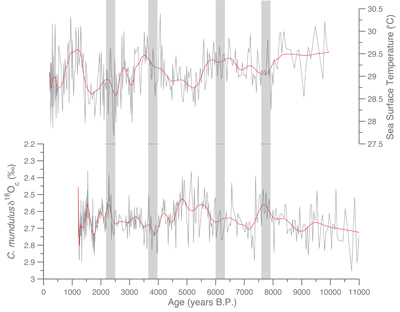Evidence for a Bipolar Seesaw During the Holocene
By:
Deborah Khider
UTIG
| When: | Friday, Sept. 30, 2011, 10:30 a.m. to 11:30 a.m. Join us for coffee beginning at 10:00 a.m. |
| Where: | Seminar Conference Room, 10100 Burnet Road, Bldg 196-ROC, Austin, Texas 78758 |
| Host: | Charles Jackson, UTIG |

Abstract
It remains unclear whether ocean heat transport contributed to Holocene
millennial-scale variability. The marine sediment core MD98-2181 (MD81) from
the edge of the Western Pacific Warm Pool is used in this study to reconstruct
tropical and high southern latitude ocean temperatures during the Holocene. The
high temporal resolution benthic foraminiferal δ18O data documents Upper Pacific Deep Water temperature and salinity variability that originates within the Southern Ocean.
Millennial-scale variability in the benthic δ18O values is on the
order of ~0.1% indicating an ~0.5°C Pacific Deep Water temperature change.
Further, lower deep water temperatures coincided with higher sea surface
temperatures (SSTs) in the western tropical Pacific of ~0.5-1°C (estimated from
the paired Mg/Ca and δ18Oc measurements on the planktonic foraminifer
Globigerinoides ruber). The last millennial oscillation in the planktonic record
corresponds to the Northern Hemisphere Medieval Climate Anomaly/Little Ice
Age. Taken together, the tropical SST and Pacific Deep Water records suggest
Southern Ocean temperature changes were anti-phased with that of the Northern
Hemisphere, an observation that is consistent with a bi-polar seesaw
mechanism.




